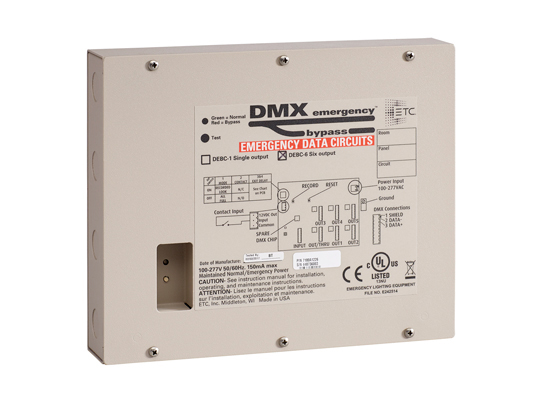How do I connect an Emergency Bypass Detection Kit (EBDK) and a DMX Emergency Bypass Controller (DEBC)?
- Last updated
- Save as PDF
Background
- Emergency Bypass Detection Kit (EBDK)

- The EBDK is designed to sense the presence of normal power in a system, and provide a switched output (contact closure) in the event that normal power is lost. This switched output can be landed on any product that accepts an external panic trigger.
- Example: since most racks do not have built-in power-loss detection, you could use the EBDK to trigger a rack into Panic mode when normal power goes out.
- DMX Emergency Bypass Controller (DEBC)

- The DEBC is designed to generate a DMX signal output on receiving a switched input.
- Example: if you have LED fixtures that need to turn on in an emergency, you could trigger the DEBC to send DMX to drive all the fixtures to full.
Explanation
The EBDK and the DEBC are designed to work as two separate products, and are often installed independently of one another, depending on the needs of each individual site.
Having said that, they are just as often installed together to work in tandem. Since the EBDK is unable to output DMX, and the DEBC is unable to detect loss of power, together they create a system that automatically generates a DMX signal on the detection of loss of normal power.
Solution
First, ensure that your EBDK is wired to correctly monitor normal power, and that your DEBC is correctly wired for DMX output to whatever you are driving on in an emergency situation. Please check the setup / installation guides for clarification (see Related Links).
To connect the two devices, follow these steps:
- First, configure your DEBC as Normally Closed (preferred) or Normally Open using Dipswitch 2.
- If your DEBC is configured as Normally Closed, run wire from the "NC" (sometimes labeled "Open in Emergency") and "Common" terminals of any of the three "Output" sections available on the EBDK.
- If your DEBC is configured as Normally Open, run wire from the "NO" (sometimes labeled "Closed in Emergency") and "Common" terminals of the EBDK instead.
- Since the EBDK generates a maintained dry contact, land those wires on the "V out" and "In" terminals of the DEBC.
The EBDK, when it detects a loss of normal power, will now generate a closure that will trigger the DEBC into emergency (DMX bypass) mode to send a DMX signal out to the system.
Troubleshooting
When the EBDK is in Emergency mode, but the DEBC is not... please check the following:
1. If your DEBC is configured as Normally Closed, is there continuity between the EBDK output's "NC" and "Common" terminals when in Emergency mode? There should be.
2. If your DEBC is configured as Normally Open, is there continuity between the EBDK output's "NO" and "Common" terminals when in Emergency mode? There should be.
NOTE: If you are having trouble getting these two products to show correct statuses, make sure the Fire Alarm jumper is installed or removed for proper setup, according to the EBDK Setup Guide (see Related Links).
Related Links

